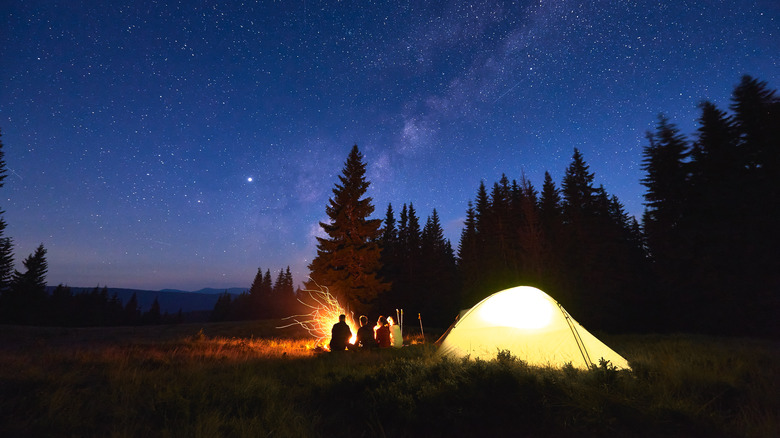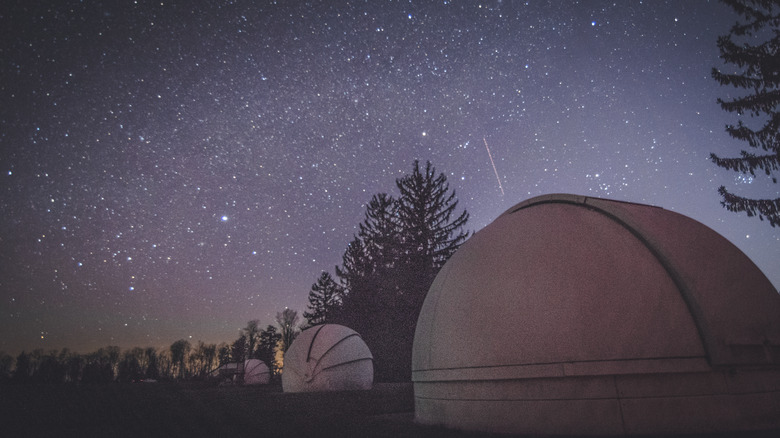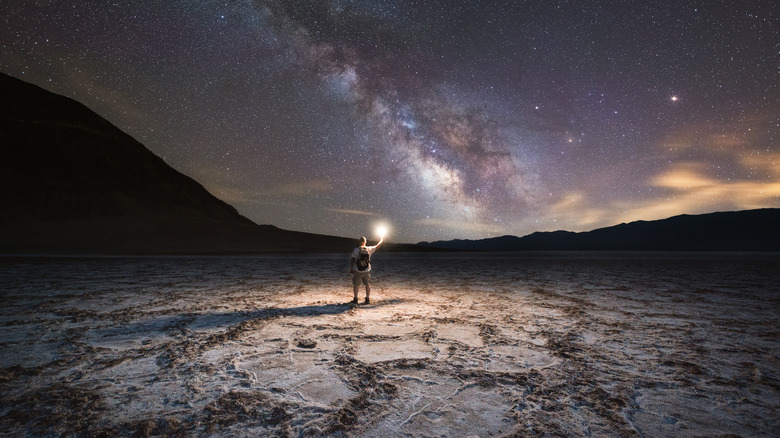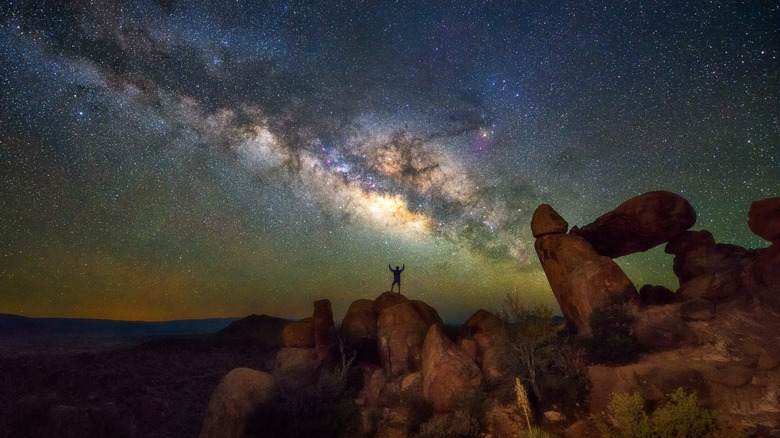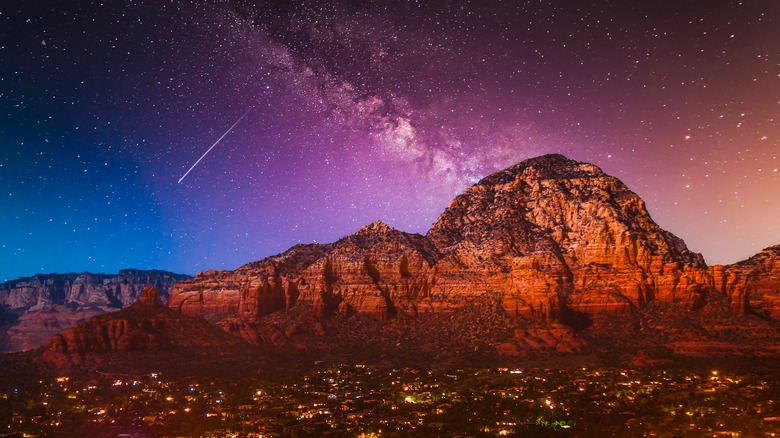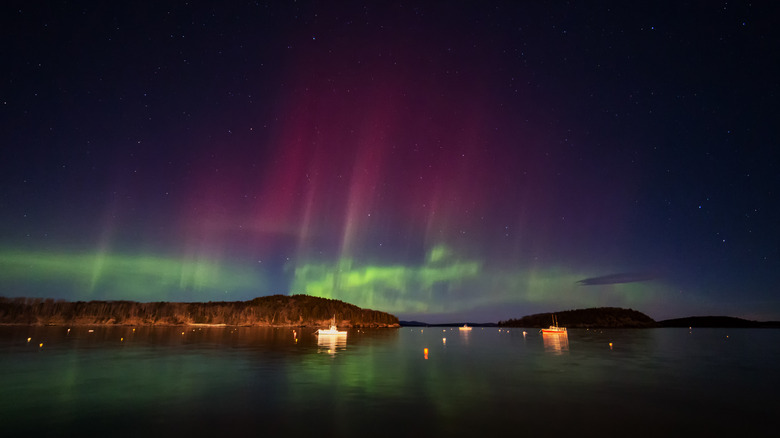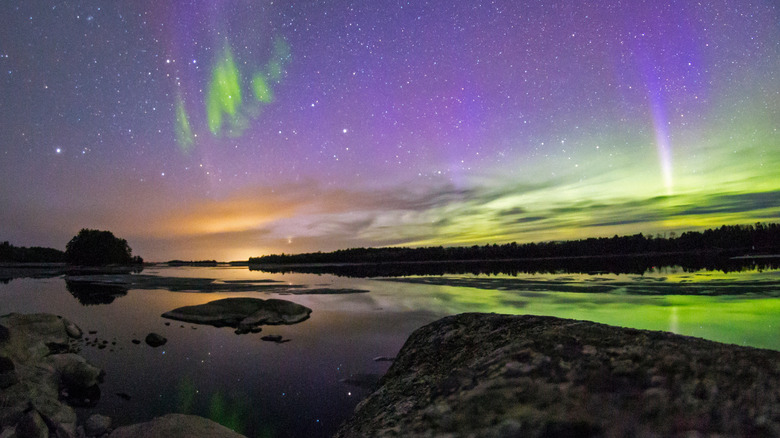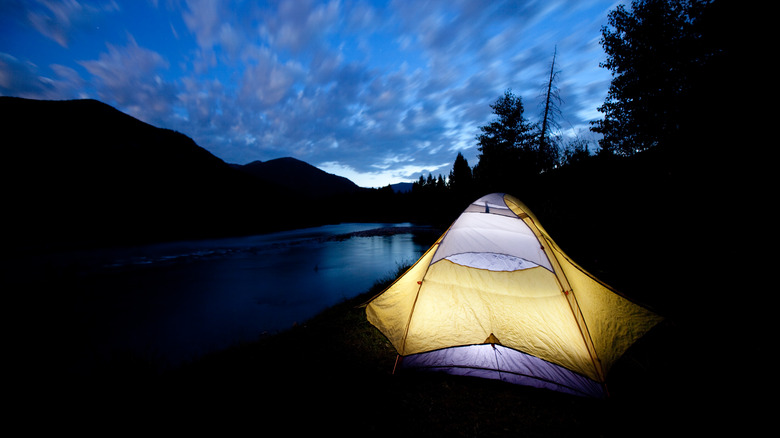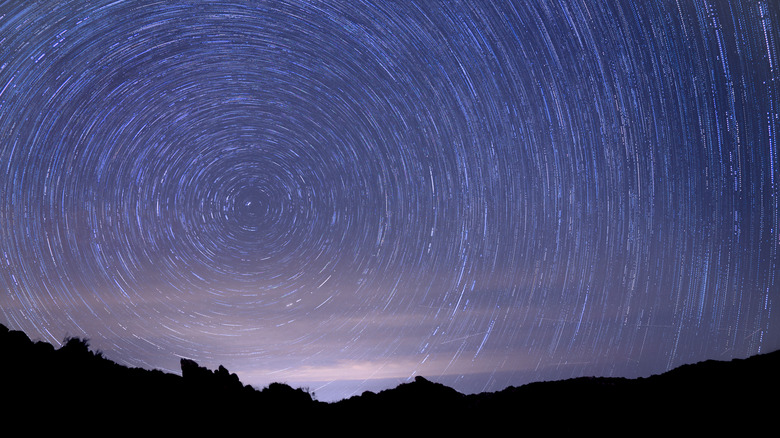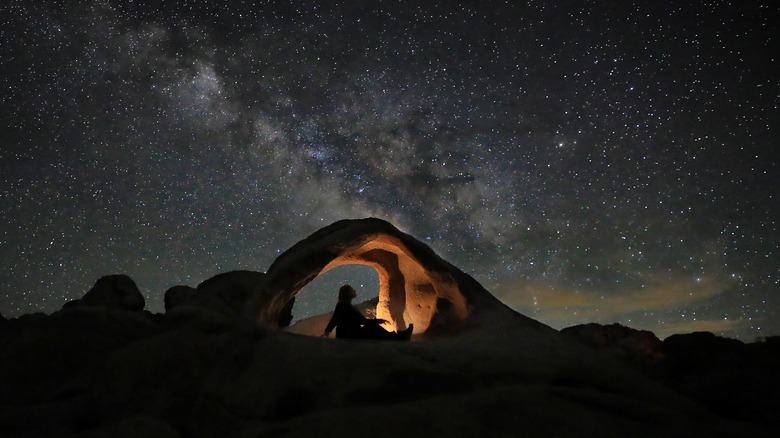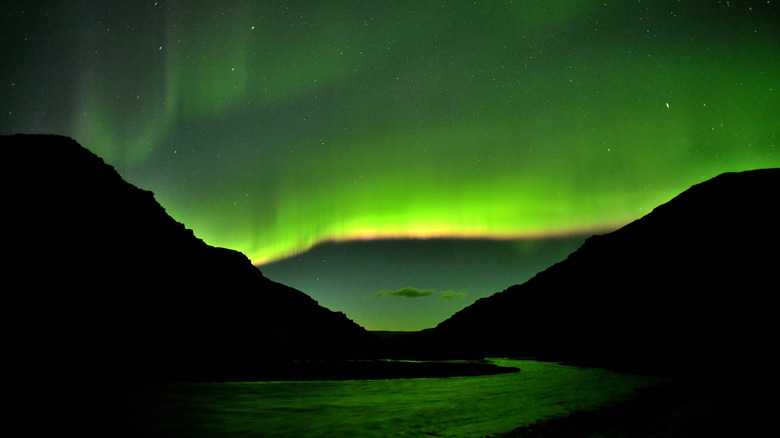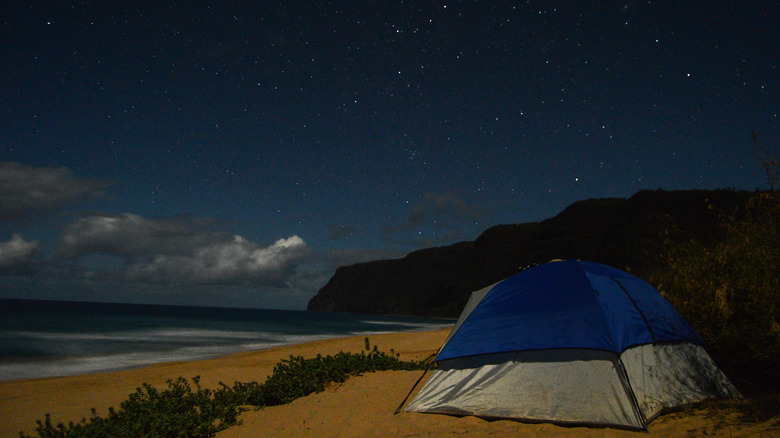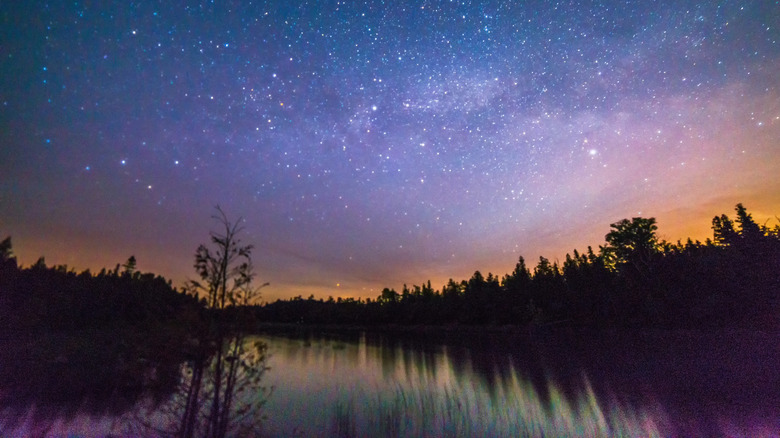12 Spectacular Places To Camp Under The Stars In The U.S.
Everyone on Earth may look at the same night sky, but its appearance depends on where you are when gazing up at it. In the modern electric world, a whopping 99% of Americans can't properly see the stars, according to a 2016 study published in Science Advances. City lights have replaced the stars coating the sky, which is one compelling reason to leave them behind and head out into the wilderness for a few nights.
If you're planning a camping trip around a star-filled night sky, some destinations reign supreme in the stargazing community. There are well over 100 official Dark Sky Places in the United States, and they showcase much more than just a few faint constellations. We've scoured the U.S. for spots to camp with superior night sky views, where meteor showers, the Northern Lights, and the Milky Way Galaxy are visible, central attractions. Keep in mind that these destinations are largely protected parks and wilderness areas, and the only trace that should remain in your wake is the impression it leaves on you.
1. Cherry Springs State Park - Coudersport, Pennsylvania
Atop the Allegheny Plateau in the Appalachian Mountains, Pennsylvania's Cherry Springs State Park has one of the best night sky views on the East Coast. Due to its peak elevation for the area and lack of obstructions, visitors have a wide-open view of the sky. The park has restrictions on light pollution and built-in observation pods, making it even easier for guests to get a clear view of the celestial bodies and events. Serious stargazers at Cherry Springs State Park should opt for the Overnight Astronomy Observation Field. Strict light restrictions allow for clear views of the Milky Way and the Northern Lights. This section of the park also has electric hookups for your astronomy gear and even offers Wi-Fi.
Since campers come to Cherry Springs State Park to look at the stars, people generally follow the rules and respect fellow gazers' needs. The red glow of white light replacements can be seen throughout the park, creating an ideal and calming environment for taking in the heavens. You'll also have plenty of people to talk to who understand your love of nebulae and star systems, even late into the night. The park is open year-round, but its campground is only available during the peak season from mid-April to late October. This is when you'll want to come for the best experience and views.
2. Death Valley National Park - California and Nevada
An ideal place to lay beneath the stars, Death Valley National Park mainly spans part of California while reaching slightly into Nevada. This grimly named park has garnered a reputation for its extreme conditions and an equally dramatic night sky. Visitors can find some of the darkest nights in the country there, which means you could catch sight of a celestial body not visible at other popular stargazing sites.
One of the best national parks on the West Coast, Death Valley has several backcountry camping spots that would be ideal for stargazing and exploring in general. Badwater Basin, a salt flat that stretches around 200 square miles, is a great place to set up camp for a night of observing the heavens. Mesquite Flat Sand Dunes is another favorite stargazing spot, made even more special by the sunset and sunrises that spill over its shapely landscape.
Planning your Death Valley trip for the new moon is best, as the lack of moonlight will create a darker sky. Luckily, there's about one of those a month, but you should choose one that falls in either winter or spring. The winter weather is much more bearable, though you need to pack for cold nights. The spring can bring a super bloom of wildflowers, a striking foil to scattered stars come nightfall.
3. Big Bend National Park - Texas
The Southwest region of the United States boasts some of the most beautiful and clear night skies, and plenty of gorgeous parks allow visitors to camp beneath them. Big Bend National Park in Southwestern Texas offers a gold-tier dark sky, thanks to the lack of light from cities or towns. According to the National Park Service, Big Bend is the least polluted national park in terms of light in the continental U.S., making it an ideal place to stargaze.
Big Bend National Park has four dedicated campgrounds and allowances for backcountry camping. This enables campers to practically hand-pick a great spot to spend the night stargazing. Spring is the peak period for Big Bend, but camping season is a bit more widespread from November to April. This is also an excellent time for stargazing, as you're more likely to avoid stormy skies.
Like most primitive camping destinations, you must be mindful of the wildlife in Big Bend. To keep bears and javelinas out, you should place food and perishables in an animal-proof box, like the lockers provided at backcountry campsites. It's not just the wild residents of the park you need to prepare for, though, as the heat and lack of water can also be a concern. Come with more water than you think you'd need, especially since you'll likely have more waking hours when staying up to stargaze!
4. Sedona, Arizona
Typically, you will want to stay far away from towns and cities when planning a stargazing trip. However, the town of Sedona is a designated Dark Sky Place and takes measures to minimize light pollution. The town's light ordinances result in some pretty great stargazing opportunities, and views of the Milky Way, Jupiter, and Mars are available on clear nights.
The best way to see the stars at night in Sedona is to find a great camping spot among the red rocks. There are many official campgrounds in the area, whether you enjoy RV camping, glamping, or sleeping in your own tent. Free camping is also allowed on the many forest roads. Sedona is a spiritual town, with some believing in a mystical vortex around Boynton Canyon, and finding a backcountry camping spot nearby could prove extra magical.
The summer months of July and August bring lots of rain to Sedona, which can cloud the sky and make stargazing difficult. Any other time of year can result in some tremendous celestial experiences, but consider your comfort level with Sedona's desert heat. Camping season, when the campgrounds are officially open, happens from April to October, but free camping is allowed year-round.
5. Acadia National Park - Maine
Besides Alaska, Maine is one of the go-to spots for stargazers who want to see the Northern Lights in the United States. Acadia National Park offers coastal views of the sky, and there's something special about seeing the dancing lights of the Aurora Borealis over the water. Though the campgrounds are only open in the park during the summer, you still have the chance to see the green light show during this period.
While there are many fantastic places to spot some stars, like Cadillac Mountain and Sand Beach, campers must stick to official campgrounds when staying overnight. No backcountry camping is allowed anywhere in Acadia National Park. The many beaches lining the park are great spots to enjoy the night sky, and Schoodic Woods Campground is right on the sand and away from light pollution. This makes it the perfect place to stargaze overnight legally within the area.
Schoodic Woods Campground is on the Schoodic Peninsula and has spotty cell service at best, so be prepared for your phone to be unreliable. The campground is open from late May to mid-October, and reservations must be made beforehand. It's also worth noting that alcohol is not permitted to be consumed in excess anywhere in the park, so keep the late-night star sessions mild if you plan to sip on some spirits.
6. Voyageurs National Park - Minnesota
There is something about a night sky full of stars over the water — the two just go together. Water plays a central role in Minnesota's Voyageurs National Park, as nearly 40 percent of it is aquatic and made up of lakes. If you are camping there, you will need to traverse the water, as boats are required to reach campsites. The extra effort is well worth the view once night falls.
Summer nights are the best for stargazing in Voyageurs National Park, as that time of year offers excellent positioning of the Milky Way. Alternatively, you can camp during the winter for an increased chance of spotting the Northern Lights. The lakes will ice over when the temperature drops, so traversing the waters could get tricky at that time of year. However, the park hosts an annual star party in February, so plenty of stargazers will brave the Minnesota winter.
Backcountry camping and designated campgrounds are available. Campsites are scattered throughout the park; you must make a reservation and obtain a permit to use them. Voyageurs National Park is a designated Dark Sky Park, and pretty much any place you choose to pitch your tent will result in a mesmerizing view.
7. Glacier National Park - Montana
Montana's Glacier National Park is one of the most visited national parks in the U.S. and its gorgeous landscapes certainly account for its popularity. However, once the sun goes down, the park shows an entirely different side of its beauty. It not only protects its skies from light pollution to ensure visitors get an eye full, but Glacier National Park also encourages stargazing with ranger-led astronomy programs every night at its observatory.
Camping is allowed throughout the park in the wilderness and at campsites, some of which are first come, first serve, while others require reservations. You will need a wilderness permit for those opting for one of the backcountry sites. If you choose one of the more popular reservation campsites, you should book around six months in advance. Each campground has different closure schedules, with some unavailable during the winter.
You will be met with amazing views of the sky year-round at Glacier National Park. The winter season, however, is when you will have the largest chance of seeing the Northern Lights. If you are more of a social stargazer, come during the summer to participate in astronomy events.
8. Anza-Borrego Desert State Park - Borrego Springs, California
Southern California's Anza-Borrego Desert State Park offers gorgeous, soft colors throughout the day with its desert flowers and mountain sunrises. After sunset, the sky shines with stars and other celestial bodies. The impressive night sky is made possible by the town of Borrego Springs' dedication to maintaining a sky that is as natural as possible. Even with large cities like San Diego being in the distance, the park has a silver-tier Dark Sky ranking.
Anza-Borrego Desert State Park helps to protect the Colorado Desert and is one of the largest state parks in the country, and backcountry camping is welcomed. This means there are plenty of spots to make yourself a home for the night, whether you'd prefer to settle in the mountains or the valley below. Stargazers often opt for a higher elevation when looking for an ideal spot. However, the park's valley offers a star-studded sky lined with the silhouette of the shapely mountains, making for a gorgeous night.
Consider planning your trip to Anza-Borrego Desert State Park around the cusp of spring for a chance to see the wildflowers in full bloom. The contrast of the flowers during the day and the constellations at night makes for an extra special camping trip. If comfort is your main concern while spending the night lying outdoors under the stars, anything from October to May will bring cool temperatures.
9. Arches National Park - Utah
Arches National Park is located in Utah, right outside of Moab. The area is famous for its large red rock formations, and spending the night among them is a special experience. The red rocks may steal the spotlight during the day, but their silhouettes only add to the beauty of the sky during the night. The park has silver status with DarkSky International, meaning that clear nights here bring an ocean of stars overhead.
Despite how freeing the desert makes visitors feel, camping is only allowed in designated areas. There are four backcountry camping areas, all requiring a permit to use. The only established campground is Devils Garden Campground, which you will need to make a reservation to stay at. Wood fires and pets are not allowed at the backcountry sites but are permitted at Devils Garden. Mind your park manners and hike out all trash, leaving the park the same way you found it.
Winter nights during the new moon will, of course, give campers the darkest nights to stargaze. However, the spring and fall are typically the peak season for camping at the park. The cool weather allows for easier exploration and comfort when stargazing. Since there is only one option for an established campground, it's important to note that Devils Garden is open year-round but gets busy from March to November.
10. Denali National Park and Preserve - Alaska
Alaska is hands down the best U.S. state to see the Northern Lights, and stargazers flock here for the colorful night skies. Denali National Park and Preserve is one of the best places in the state to view them, and a star-filled sky, as it's north enough, away from city lights, and offers ample camping opportunities. You must come prepared for the elements, but campers will be in awe of Denali's night sky.
Denali National Park allows backcountry camping and has established campgrounds. Reservations are not required for campgrounds, but obtaining a free permit is for backcountry camping is. Though not required, it's a good idea to reserve a spot at the campground of your choice if you know you'd like to stay there. They fill up sometimes, and Riley Creek Campground is a great stargazing spot. Dedicated stargazers may wish to opt for backcountry camping, though, as darker, clearer skies will be found away from campgrounds.
Campers love visiting Denali during the summer months, but those with the goal of admiring the night sky may plan differently. Summer brings rain here, and rain brings a not-so-clear sky. This makes the other three seasons more ideal for stargazing, and both campgrounds and backcountry camping are generally available year-round. Those with their sights set on the Northern Lights will be thrilled to learn that the phenomenon happens year-round here.
11. Polihale State Park - Waimea, Hawaii
Beaches aren't just for soaking up some sun; they're also great under the night sky. Hawaii has some of the most famous, sought-after beaches in the country, and the beauty of the island state is known throughout the world. The tropical paradise's intense night sky doesn't get nearly as much hype when compared to Hawaii's daytime attractions, but it's not for lack of beauty.
Camping in Polihale State Park requires an overnight camper's permit, but it's worth planning for this underrated attraction that should be on your Hawaii bucket list. You won't be pitching your tent on top of a mountain or in one of Hawaii's rainforests, but right on the beach. With sand under your feet, the view of constellations over the water is unforgettable. For the ultimate experience here, sandwich your view of the night sky with the sunset and sunrise.
One of the great benefits of camping at Polihale State Park is that you can also swim under the stars. However, this comes with some caveats, as you will need to beware of strong currents. The dirt roads leading to beachfront camping spots can be unpredictable; be wary of flooding and do not try to go off-road. Though open to campers year-round, the best time to try for a camping trip here is during times of low rainfall. Summer months also bring calmer, safer waters.
12. The Great Lakes - Michigan
If you can get away from Detroit's city lights, almost anywhere in Michigan offers some awe-inspiring sky sights. The Great Lakes, of which Michigan touches four, offer some of the best opportunities to see a stellar night sky here. It certainly doesn't hurt that several Dark Sky places have been established around Michigan's Great Lakes.
Though all these designated places are ripe with amazing stargazing opportunities, some do not permit camping. This doesn't mean you have to discount them, though, as there are campgrounds in the surrounding area with the same sky. Keweenaw Dark Sky Park on Lake Superior is a great place to look up at the night sky, and campsites like Trails End Campground are an easy five-minute drive away. Campers can also head to Thompson's Harbor State Park to camp amongst the sand dunes on the coast of Lake Huron, a Dark Sky place that does permit camping.
It's easy to find campgrounds in Michigan's Great Lakes area open year-round. Stargazers have a lot of flexibility here, as all seasons offer excellent night sky views. The time of year you stargaze here will boast different sights, though. Summer months will provide breathtaking views of the Milky Way, while a winter trip could show off the Geminid meteor shower.
